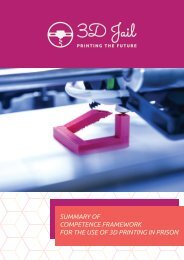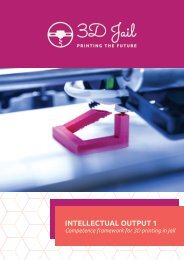Training models for the use of 3D printing technology in prison
3D Jail project further involves a training program for the training and development of trainers who are going to deliver the training program for inmates. Trainers are required to have basic computer, CAM and CAD skills. For the training of the trainers has also been planned an in-service training program to cover information on general characteristics of penitentiary institutions and inmates, use of the e-learning portal, and 3D printing.
3D Jail project further involves a training program for the training and development of trainers who
are going to deliver the training program for inmates. Trainers are required to have basic computer,
CAM and CAD skills. For the training of the trainers has also been planned an in-service training
program to cover information on general characteristics of penitentiary institutions and inmates, use
of the e-learning portal, and 3D printing.
Create successful ePaper yourself
Turn your PDF publications into a flip-book with our unique Google optimized e-Paper software.
Preparing the training courses
From the prison regulations and experiences to their adaptability to new
technologies
In the creation of training paths to the use of 3D printing technology suitable for penitentiary realities,
a first step is the understanding of how it can be adaptable to a complex context, such as prison, a
type of training that in itself is technical, specialized and constantly evolving.
Technology has transformed the way we approach most daily tasks and activities. It plays a role in how
we apply for and perform on a job, communicate with friends and family, access government and
other services, manage our finances, and purchase entertainment. Technology also enables our
learning. Recognizing the positive impact that technology can have on education, the partnership of
3D Jail developed a research on prison experiences and regulations and their adaptability to new
technologies. This research outlines how educational systems in Europe could use advanced
technologies to support student learning regardless of backgrounds, languages, and disabilities;
instruction and the professional development of teachers; data collection and analysis; and program
improvement. More specific, a corresponding plan describes how the 3D printing technologies can be
applied to the adult education field and adult learners.
As countries, regions, higher education institutions and other education providers implement these
plans, education programs in prison facilities are being left behind. The policies and practices of federal
and local prison agencies, including the juvenile justice system, severely hinder the ability of prison
education programs to enable learning through technology. For example, although most European
countries offer students limited use of computers in their prisons, few of them reported that one or
more of their prisons provided students with off-line access to Internet content and even fewer
allowed restricted Internet access. The primary concern about adopting educational technology in
prison is the potential for security breaches. Other reasons include, but are not limited to, insufficient
resources and staff capacity to purchase, implement, maintain, and monitor advanced technologies.
Despite these legitimate concerns, a slight change is occurring in prisons. As advanced technologies
are integrated into other areas of some new penitentiaries (e.g., family communications via e-mail
and video conferencing, and access to health and treatment services via telemedicine), a growing
number of prison agencies and facilities and their education partners are exploring ways to securely
and cost-effectively increase access to educational technology. Specifically, they are cautiously
adopting advanced technologies to
●
●
●
help prepare students to join our globally networked society by developing and improving
their computer and digital literacy skills, making educational gains around the clock through
computer-assisted instruction, accessing college courses, and preparing for employment;
provide students with access to online assessments (e.g., online high school equivalency tests
and industry-recognized certification exams), and instructors and administrators with the
ability to measure student progress for program improvement purposes;
expand the professional development resources available to instructors and equip them with
technology-based instructional tools (e.g., open educational resources, learning management
systems, and flipped classrooms) to enhance the classroom experience;
3DJail printing the future – IO2
4





